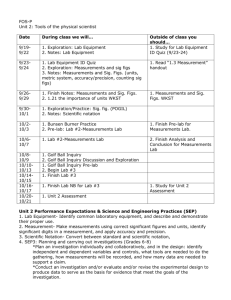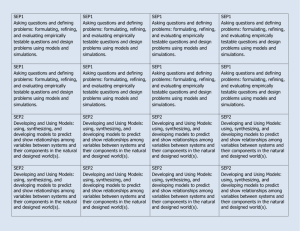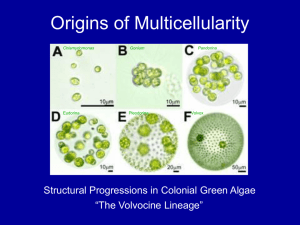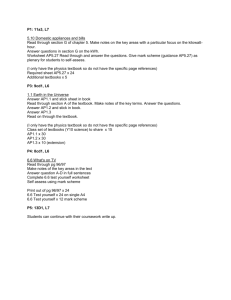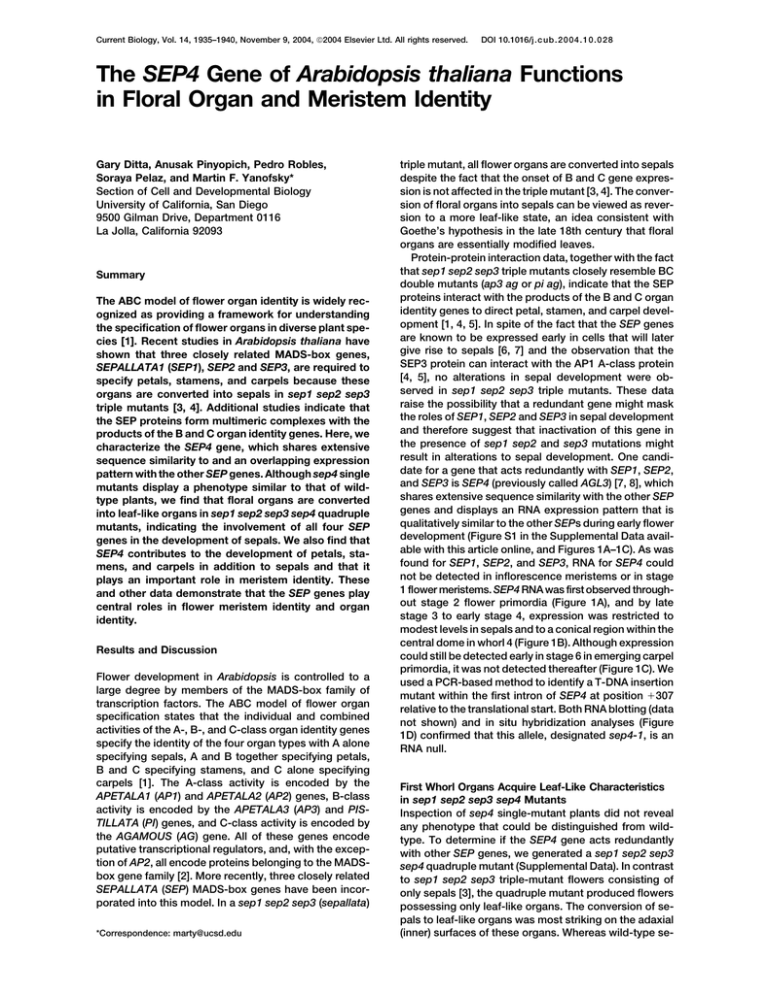
Current Biology, Vol. 14, 1935–1940, November 9, 2004, 2004 Elsevier Ltd. All rights reserved.
DOI 10.1016/j .c ub . 20 04 . 10 .0 2 8
The SEP4 Gene of Arabidopsis thaliana Functions
in Floral Organ and Meristem Identity
Gary Ditta, Anusak Pinyopich, Pedro Robles,
Soraya Pelaz, and Martin F. Yanofsky*
Section of Cell and Developmental Biology
University of California, San Diego
9500 Gilman Drive, Department 0116
La Jolla, California 92093
Summary
The ABC model of flower organ identity is widely recognized as providing a framework for understanding
the specification of flower organs in diverse plant species [1]. Recent studies in Arabidopsis thaliana have
shown that three closely related MADS-box genes,
SEPALLATA1 (SEP1), SEP2 and SEP3, are required to
specify petals, stamens, and carpels because these
organs are converted into sepals in sep1 sep2 sep3
triple mutants [3, 4]. Additional studies indicate that
the SEP proteins form multimeric complexes with the
products of the B and C organ identity genes. Here, we
characterize the SEP4 gene, which shares extensive
sequence similarity to and an overlapping expression
pattern with the other SEP genes. Although sep4 single
mutants display a phenotype similar to that of wildtype plants, we find that floral organs are converted
into leaf-like organs in sep1 sep2 sep3 sep4 quadruple
mutants, indicating the involvement of all four SEP
genes in the development of sepals. We also find that
SEP4 contributes to the development of petals, stamens, and carpels in addition to sepals and that it
plays an important role in meristem identity. These
and other data demonstrate that the SEP genes play
central roles in flower meristem identity and organ
identity.
Results and Discussion
Flower development in Arabidopsis is controlled to a
large degree by members of the MADS-box family of
transcription factors. The ABC model of flower organ
specification states that the individual and combined
activities of the A-, B-, and C-class organ identity genes
specify the identity of the four organ types with A alone
specifying sepals, A and B together specifying petals,
B and C specifying stamens, and C alone specifying
carpels [1]. The A-class activity is encoded by the
APETALA1 (AP1) and APETALA2 (AP2) genes, B-class
activity is encoded by the APETALA3 (AP3) and PISTILLATA (PI) genes, and C-class activity is encoded by
the AGAMOUS (AG) gene. All of these genes encode
putative transcriptional regulators, and, with the exception of AP2, all encode proteins belonging to the MADSbox gene family [2]. More recently, three closely related
SEPALLATA (SEP) MADS-box genes have been incorporated into this model. In a sep1 sep2 sep3 (sepallata)
*Correspondence: marty@ucsd.edu
triple mutant, all flower organs are converted into sepals
despite the fact that the onset of B and C gene expression is not affected in the triple mutant [3, 4]. The conversion of floral organs into sepals can be viewed as reversion to a more leaf-like state, an idea consistent with
Goethe’s hypothesis in the late 18th century that floral
organs are essentially modified leaves.
Protein-protein interaction data, together with the fact
that sep1 sep2 sep3 triple mutants closely resemble BC
double mutants (ap3 ag or pi ag), indicate that the SEP
proteins interact with the products of the B and C organ
identity genes to direct petal, stamen, and carpel development [1, 4, 5]. In spite of the fact that the SEP genes
are known to be expressed early in cells that will later
give rise to sepals [6, 7] and the observation that the
SEP3 protein can interact with the AP1 A-class protein
[4, 5], no alterations in sepal development were observed in sep1 sep2 sep3 triple mutants. These data
raise the possibility that a redundant gene might mask
the roles of SEP1, SEP2 and SEP3 in sepal development
and therefore suggest that inactivation of this gene in
the presence of sep1 sep2 and sep3 mutations might
result in alterations to sepal development. One candidate for a gene that acts redundantly with SEP1, SEP2,
and SEP3 is SEP4 (previously called AGL3) [7, 8], which
shares extensive sequence similarity with the other SEP
genes and displays an RNA expression pattern that is
qualitatively similar to the other SEPs during early flower
development (Figure S1 in the Supplemental Data available with this article online, and Figures 1A–1C). As was
found for SEP1, SEP2, and SEP3, RNA for SEP4 could
not be detected in inflorescence meristems or in stage
1 flower meristems. SEP4 RNA was first observed throughout stage 2 flower primordia (Figure 1A), and by late
stage 3 to early stage 4, expression was restricted to
modest levels in sepals and to a conical region within the
central dome in whorl 4 (Figure 1B). Although expression
could still be detected early in stage 6 in emerging carpel
primordia, it was not detected thereafter (Figure 1C). We
used a PCR-based method to identify a T-DNA insertion
mutant within the first intron of SEP4 at position ⫹307
relative to the translational start. Both RNA blotting (data
not shown) and in situ hybridization analyses (Figure
1D) confirmed that this allele, designated sep4-1, is an
RNA null.
First Whorl Organs Acquire Leaf-Like Characteristics
in sep1 sep2 sep3 sep4 Mutants
Inspection of sep4 single-mutant plants did not reveal
any phenotype that could be distinguished from wildtype. To determine if the SEP4 gene acts redundantly
with other SEP genes, we generated a sep1 sep2 sep3
sep4 quadruple mutant (Supplemental Data). In contrast
to sep1 sep2 sep3 triple-mutant flowers consisting of
only sepals [3], the quadruple mutant produced flowers
possessing only leaf-like organs. The conversion of sepals to leaf-like organs was most striking on the adaxial
(inner) surfaces of these organs. Whereas wild-type se-
Current Biology
1936
Figure 1. RNA In Situ Analysis of SEP4 Expression
Expression is first detected and is strongest during stage 2 (A and B) but is not seen in the inflorescence meristem. By stages 3–4 (B),
expression is localized to a conical region within the central dome and can be weakly detected in sepals. Expression persists into stage 6 in
carpels but is no longer visible in sepals (C). Expression was not detected at later stages. No expression is seen for a sep4 mutant also
determined to be an RNA null by Northern blot analysis (D). Abbreviations are as follows: 2, 3, 4, and 6 ⫽ stages of Arabidopsis flower
development; IM ⫽ inflorescence meristem; s ⫽ sepal.
pals have an abundance of elongated rectangular cells
aligned parallel to one another (Figure 2A), the adaxial
surfaces of sep1 sep2 sep3 sep4 floral organs (Figure
2D) were found to consist almost entirely of irregular
puzzle-shaped cells typical of those normally found on
leaves (Figure 2C). Although the cells on the surfaces
of sep1 sep2 sep3 triple-mutant sepals (Figure 2B) were
similar to those found on wild-type sepals, close inspection revealed cells with slightly irregular edges, suggesting a partial adoption of leaf fate. The adaxial surfaces of first-whorl organs on plants with other sep
genotypes such as sep1 sep 2 sep4 and sep3 sep4 were
unaffected (data not shown), suggesting that all four
SEP genes must be inactivated for the adaxial surface
of sepals to adopt a leaf-like fate.
In contrast to the leaf-like appearance of the adaxial
epidermal cells of sep1 sep2 sep3 sep4 mutant flower
organs, the abaxial (outer) epidermal cells of these organs appeared to have a mixture of both leaf- and sepallike characteristics. The most obvious leaf-like feature
was an abundance of branched (stellate) trichomes, particularly on the outermost (first whorl) organs (Figures 2G
and 2J, yellow arrows). Although less frequent, stellate
trichomes were also observed on adaxial surfaces in
the quadruple mutant. Stellate trichomes are a feature
of rosette and cauline leaves in Arabidopsis and are
seldom observed on sepals of either wild-type (Figures
2E and 2H) or the sep1 sep2 sep3 triple mutant (Figures
2F and 2I), both of which typically have simple, unbranched trichomes. Although the number of trichomes
declined in later-arising flowers of the quadruple mutant,
such trichomes when present were predominantly of the
branched type. Close inspection of cells on the abaxial
surface of the quadruple mutant revealed features similar to the sepals of both wild-type and the sep1 sep2
sep3 triple mutant, such as the overall arrangement of
epidermal cells and the presence of large, elongated
cells (Figures 2H–2J, blue arrows). Another characteristic feature of leaves in Arabidopsis is that they have
small appendages at their base called stipules, which
are not present at the base of sepals. Structures resembling stipules were observed at the base of the leaf-like
organs in the flowers of sep1 sep2 sep3 sep4 quadruple
mutants.
Taken together, these data indicate that sepals adopt
features of leaves in the sep1 sep2 sep3 sep4 quadruple
mutant and suggest that the four SEP genes have overlapping activities required for normal sepal development. The leaf-like phenotype of organs in the sep1 sep2
sep3 sep4 quadruple mutant resembles that seen for
ABC mutants of genotypes ap2-1 ap3-1 ag-1, ap2-1 pi-1
ag-1, or ap2-2 pi-1 ag-1 [1]. The fact that floral organs
default to leaf-like organs when developmental specification is removed supports the notion that flower organs
represent modified leaves.
Although floral organs in the sep1 sep2 sep3 sep4
mutant resemble leaves, it is clear that they also retain
some features characteristic of sepals, suggesting the
involvement of a SEP-independent function in specifying sepal identity. However, the fact that the sep2-1
and sep3-2 alleles are derived from the insertion of the
autonomous transposable element En-1 (see the Supplemental Data available with this article online) leaves
open the possibility that these residual sepal characteristics are the result a partial restoration of SEP activity
after excision of the En-1 element.
SEP4 Contributes to Organ Development
in All Four Whorls
The conversion of sepals into leaf-like organs in the
sep1 sep2 sep3 sep4 quadruple mutant indicates that
SEP4 contributes to sepal identity. To determine if SEP4
also contributes to petal, stamen, and carpel identity,
we introduced sep4 into plants that were homozygous
for mutations in SEP1 and SEP2 and heterozygous for
mutation in SEP3 but wild-type for SEP4. Such sep1
sep2 sep3/⫹ plants develop flowers that look normal
except for a reduction in the number of stamens (Figures
3A and 3B). When a sep1 sep2 sep3/⫹ sep4 mutant was
generated, profound changes were observed in earlyarising flowers (Figure 3C). Both organ number and organ identity were affected in a highly variable manner.
Dissection of the individual organs of a typical earlyarising flower from this mutant (Figure 3C) revealed two
aberrant sepal-like organs, one sepal-petal hybrid, six
abnormal stamens, and carpels with stellate trichomes
on the valves (Figure 3C, inset). Stellate trichomes are
never observed on wild-type carpels but were frequently
SEP4 Mediates Floral Patterning in Arabidopsis
1937
Figure 2. Floral Organs Resemble Leaves in
sep1 sep2 sep3 sep4 Mutants
The adaxial surface of wild-type (A) and sep1
sep2 sep3 (B) mutant sepals consists primarily of elongated rectangular cells in a parallel
arrangement. In contrast, cells on the adaxial
surface of leaves have an irregular and interlocking shape (C). Cells on the adaxial epidermis of first whorl organs in sep1 sep2 sep3
sep4 closely resemble those of leaves (D).
Stomata are present in each instance (A–D).
Sepals from flowers of wild-type (Col) (E and
H) and sep1 sep2 sep3 (F and I) have simple
unbranched trichomes on the abaxial surface
whereas the first whorl organs of sep1 sep2
sep3 sep4 (G and J) have predominantly
branched stellate trichomes (yellow arrows).
The rest of the abaxial surface, including the
epidermal cell structure (blue arrows) appears equivalent in each case (H–J).
observed on those of sep1 sep2 sep3/⫹ sep4 plants.
The gynoecium was often supported by an elongated
gynophore, and many flowers displayed a loss of fourthwhorl determinacy such that flowers arose within flowers (Figure 3D). This loss of floral meristem determinancy
is a well-documented feature of situations in which C-function activity is compromised [9]. The severe distortions
of floral organ development that were seen in early flowers lessened over time so that later-arising flowers appeared more normal. However, even later-arising flowers
displayed significant perturbations of organ development
(Figure 3E). Eventually, plants with a sep1 sep2 sep3/⫹
sep4 genotype set viable seed.
These data suggest that the SEP genes contribute to
floral organ development in a redundant and additive
fashion. While a sep1 sep2 sep3/⫹ mutant has enough
remaining SEP function to support relatively normal
flower development, the removal of SEP4 lowers overall
SEP activity below a threshold critical for proper floral
organ development. Because the loss of SEP4 can affect
the development of all four organ types, it is apparent
that SEP4 plays a role in petal, stamen, and carpel development as well as in sepal development. Since previous
work [3, 4] and work presented here show that SEP1,
SEP2, and SEP3 play roles in specifying the development of sepals, petals, stamens, and carpels, we conclude that all four SEP genes are important for the development of all four whorls of Arabidopsis flowers.
It should be noted that, whereas the data indicate
overall SEP functionality to be fundamentally additive,
individual SEP genes nevertheless contribute disproportionately to organ development. The removal of two copies of SEP4 from a sep1 sep2 sep3/⫹ background (described above), for example, has a less dramatic effect
on flower development than does removal of the single
remaining copy of SEP3 (sep1 sep2 sep3), whereas a
Current Biology
1938
Figure 3. SEP4 Functions in All Four Floral Whorls
A Col wild-type flower is shown in (A). sep1 sep2 sep3/⫹ flowers are fertile and set seed but have a reduced number of stamens (B). An earlyarising flower from a sep1 sep2 sep3/⫹sep4 plant shows striking alterations in organ development that are variable from flower to flower (C).
As well as variations in organ number and identity, the elongated pedicel and stellate trichomes on the carpel valves (inset) of this flower are
typical of many flowers. Another frequent occurrence is a loss of floral determinacy such that flowers arise within flowers. In (D), a carpel has
been opened to reveal the additional carpel and stamens contained alongside developing ovules. Later-arising flowers show a less severe
phenotype (E). Even here, however, a split petal occurs as a first whorl organ, in addition to a bifurcated stamen, a bent carpel, and overall
reduced organ number. An elongated pedicel of an axilary flower can be seen on the right.
sep1 sep2 sep4 mutant shows no significant perturbation of floral organ development (data not shown). These
observations suggest that SEP3 is significantly more
critical for flower development than SEP4. Whether this
difference is attributable primarily to variations in protein
function or to RNA expression, however, is unknown. It
is worth noting that in vitro work has shown SEP3 to
be a significantly stronger transcriptional activator than
either SEP1 or SEP2 [4].
SEP4 Is Involved in Maintaining Meristem Identity
In addition to alterations in organ identity, sep1 sep2
sep3 triple mutants also display a slight loss of flower
meristem identity as evidenced by occasional secondary flowers in the axils of first-whorl organs [3] (Figure
S2A). The loss of floral meristem identity is even more
extreme in the case of sep1 sep2 sep3 sep4 quadruple
mutants (Figure S2B). To further examine the meristem
identity role of the SEP genes, and SEP4 in particular,
we combined various SEP mutations with mutations in
the AP1 and CAULIFLOWER [CAL] meristem identity
genes. Mutations in AP1 lead to the development of flowers in the axils of first-whorl organs, and this has been
interpreted as a partial conversion of flower meristems
into inflorescence meristems [10] (Figure 4B). This conversion is nearly complete in ap1 cal double mutants,
in which flower meristems behave like inflorescence
meristems and continuously elaborate new meristems,
resulting in a “cauliflower” phenotype [10] (Figure 4D).
Although ap1 cal double mutants elaborate meristems
for a considerable period of time, flowers resembling
those of ap1 single mutants eventually appear and set
seed. Because cal single mutants cannot be distinguished from wild-type, it appears that all of the functions of CAL are encompassed by those of AP1.
Remarkably, when we constructed the ap1 sep1 sep2
sep4 quadruple mutant, we found that these plants produced a cauliflower phenotype similar to ap1 cal mutants, even though the plants were homozygous for the
wild-type CAL gene (Figure 4F). One explanation for
these results is that the SEP proteins are required for
CAL protein activity just as they have previously been
shown to be required for activities of the B- and C-gene
products. We also found that an ap1 sep4 double mutant
had a meristem identity defect intermediate between
that of ap1 and ap1 cal mutants. Inflorescences of ap1
sep4 plants appeared cauliflower-like early after bolting
but soon began to produce ap1-like flowers on their
periphery and maintained this general appearance (cauliflower-like center, ap1-like periphery; Figure 4C) for a
considerable time before the cauliflower-like character
diminished. The intermediate nature of the ap1 sep4
phenotype suggests that a sep4 mutation has a similar
but less severe effect on maintenance of floral meristem
identity than does a cal mutation and again suggests
that SEP4 protein is required for full activity of CAL
protein.
Interestingly, we found that the sep4 mutation enhanced the meristem identity defect of ap1 cal cauliflower mutants (Figure 4E). Although inflorescences of
ap1 cal sep4 mutants looked indistinguishable from cauliflower structures formed by either ap1 cal or ap1 sep1
sep2 sep4, the ap1 cal sep4 triple mutant inflorescences
nevertheless took 7–10 days longer than ap1 cal mutants
did to begin producing flowers (unpublished data). In
ap1 cal sep4 mutants, the increased flower meristem
identity defect cannot be attributed to a decrease in
CAL function. However, since ap1 cal sep4 mutants
eventually produce flowers, it is clear that one or more
additional genes must be playing a role similar to CAL
in promoting flowering. The FUL gene, which is a close
relative of both AP1 and CAL, has been shown to function in specifying floral meristem identity and to be required for the eventual flowering of ap1 cal mutants [11].
Therefore, one interpretation for the delay in flowering
of ap1 cal sep4 is that loss of SEP4 activity results in a
decrease of FUL activity such that the ap1 cal sep4
mutant has a phenotype intermediate between that of
SEP4 Mediates Floral Patterning in Arabidopsis
1939
Figure 4. SEP4 Functions in Meristem Identity
sep4 inflorescences look completely normal (A). An ap1-15 mutant (B; strong allele of Col) lacks petals and shows a complex structure due
to the appearance of additional flowers in the axils of first whorl organs. The center of an ap1 sep4 inflorescence has a cauliflower-like
appearance but is surrounded on its periphery by flowers (C). This architecture is maintained for a prolonged period. An ap1 cal flower has
a classic cauliflower appearance (D). An ap1 cal sep4 flower looks essentially the same as ap1 cal although there are more frequent bractlike organs interspersed as displayed here (E). As discussed in the text, resolution of the cauliflower head and the initiation of fruit development
takes longer to occur in ap1 cal sep4 than in ap1 cal. An ap1 sep1 sep2 sep4 mutant forms a cauliflower-like inflorescence in the presence
of a wild-type CAL allele (F).
ap1 cal (slow to produce flowers) and ap1 cal ful (never
produces flowers). SEP4 appears to have a more important role than the other SEP genes in specifying meristem identity because other combinations of sep alleles
with ap1, such as ap1 sep1 sep2 or ap1 sep3 did not
display the cauliflower-like character (data not shown).
Overexpression of SEP4 Promotes a Floral Fate
Loss of function studies showed that SEP4 acts to promote flower meristem identity. To determine if SEP4 is
sufficient to promote a floral fate, we generated transgenic plants in which the SEP4 gene was ectopically
expressed from the CaMV35S promoter. In contrast to
wild-type inflorescence meristems, which are capable
of producing many flowers prior to senescence, constitutive expression of SEP4 resulted in the production of
fused terminal flowers in place of inflorescence meristems (Figure S3C). These terminal flowers frequently
consisted of a fusion of multiple flowers that had apparently originated from the inflorescence meristem at
around the same time, and they typically had many more
than the number of organs that a single flower would
normally produce. The fact that the inflorescence meristem terminated after producing these flowers indicates
that the ectopic expression of SEP4 was sufficient to
convert the normally indetermimate inflorescence meristem into a floral meristem. These phenotypes are similar to what has been observed for terminal flower (tfl)
mutants, in which lack of TFL activity allows the inflorescence meristem to be consumed in the production of
terminal flowers rather than be maintained in order to
produce additional flowers [12], and supports the proposed role of SEP4 in promoting flower meristem
identity.
SEP Function and Flower Development
As well as interacting with ABC proteins [4, 5], SEP3
forms transcriptionally active complexes with other proteins related to AGAMOUS known to be important for
ovule development, including STK, SHP1, and SHP2
[13]. These studies, together with demonstrated roles
for SEP genes in specifying ovule, meristem, and organ
identity ([3–5, 13, 19] and this work), show that the SEP
genes play a broad and pivotal role in flower development in Arabidopsis. SEP orthologs in other plant species are likely to play equivalently important roles in
flower development. In Petunia, for example, SEP orthologs FBP2 and FBP5 were shown to function redundantly and to be essential for B and C function activity.
Whorls 2, 3, and 4 acquired sepaloid characteristics and
thus became more leaflike in an fbp2 fbp5 double mutant
[14]. SEP orthologs have been identified in eudicot,
monocot, as well as gymnosperm species [15–18]. Such
widespread and ancient structural conservation suggests that SEP genes have been important for plant
reproduction since before the appearance of Angiosperms over 140 million years ago. The primary role of
SEP proteins appears to be in facilitating the formation
of specific transcription complexes and in conferring
upon these complexes transcription activation potential
[4, 19]. This suggests that the other MADS-box proteins
within such complexes contribute primarily to promoter
selection, although it has not been ruled out that SEP
proteins might influence this process as well. As summarized in the “floral quartet” model, a wide array of heteromeric complexes can be derived from various combinations of SEP proteins and other MADS-box proteins [20].
Because each of these is likely to possess a unique
level of transcriptional activation capability [13], it is
clear that the SEP gene family endows the cell with
Current Biology
1940
an exquisitely sensitive mechanism for controlling floral
gene expression.
Supplemental Data
Supplemental Data including Supplemental Experimental Procedures and two figures are available at http://www.current-biology.
com/cgi/content/full/14/21/1935/DC1/.
Acknowledgments
We thank members of the Yanofsky lab for comments on the manuscript and for advice and assistance throughout the course of this
work. We specifically thank Jackie Sztain for technical assistance.
We are also deeply indebted to the laboratory of Rick Amasino for
providing us with access to the library of Arabidopsis T-DNA insertion mutants from which the sep4-1 allele was isolated, and to Katia
Scortecci for technical assistance in isolating the mutant. We thank
Evelyn York at the Scripps Institute of Oceanography Analytical
Facility for assistance in using the Scanning Electron Microscope.
The work was supported by grants from the National Science Foundation and the United States Department of Agriculture (to M.F.Y.).
Received: August 13, 2004
Revised: September 10, 2004
Accepted: September 10, 2004
Published: November 9, 2004
References
1. Bowman, J.L., Smyth, D.R., and Meyerowitz, E.M. (1991). Genetic interactions among floral homeotic genes of Arabidopsis.
Development 112, 1–20.
2. Riechmann, J.L., and Meyerowitz, E.M. (1997). MADS domain
proteins in plant development. Biol. Chem. 378, 1079–1101.
3. Pelaz, S., Ditta, G.S., Baumann, E., Wisman, E., and Yanofsky,
M. (2000). B and C organ identity functions require SEPALLATA
MADS-box genes. Nature 405, 200–203.
4. Honma, T., and Goto, K. (2001). Complexes of MADS-box proteins are sufficient to convert leaves into floral organs. Nature
409, 525–529.
5. Pelaz, S., Gustafson-Brown, C., Kohalmi, S.E., Crosby, W.L., and
Yanofsky, M.F. (2001). APETALA1 and SEPALLATA3 interact to
promote flower development. Plant J. 26, 385–394.
6. Rounsley, S.D., Ditta, G.S., and Yanofsky, M.F. (1995). Diverse
roles for MADS-box genes in Arabidopsis development. Plant
Cell 7, 1259–1269.
7. Ma, H., Yanofsky, M., and Meyerowitz, E. (1991). AGL1-AGL6,
an Arabidopsis gene family with similarity to floral homeotic and
transcription factor genes. Genes Dev. 5, 484–495.
8. Huang, H., Tudor, M., Weiss, C.A., Hu, Y., and Ma, H. (1995).
The Arabidopsis MADS-gene AGL3 is widely expressed and
encodes a sequence-specific DNA-binding protein. Plant Mol.
Biol. 28, 549–567.
9. Mizukami, Y., and Ma, H. (1995). Separation of AG function in
floral meristem determinancy from that in reproductive organ
identity by expressing antisense AG RNA. Plant Mol. Biol. 28,
767–784.
10. Bowman, J.L., Alvarez, J., Weigel, D., Meyerowitz, E.M., and
Smyth, D.R. (1993). Control of flower development in Arabidopsis thaliana by APETALA1 and interacting genes. Development
119, 721–743.
11. Ferrandiz, C., Gu, Q., Martienssen, R., and Yanofsky, M.F.
(2000). Redundant regulation of meristem identity and plant
architecture by FRUITFULL, APETALA1, and CAULIFLOWER.
Development 127, 725–734.
12. Shannon, S., and Meeks-Wagner, R. (1991). A mutation in the
Arabidopsis TFL1 gene affects inflorescence meristem development. Plant Cell 3, 877–892.
13. Favaro, R., Pinyopich, A., Battaglia, R., Kooiker, M., Borghi, L.,
Ditta, G., Yanofsky, M.F., Kater, M.K., and Colombo, L. (2003).
MADS-box protein complexes control carpel and ovule development in Arabidopsis. Plant Cell 14, 2603–2611.
14. Vandenbussche, M., Zetho, J., Souer, E., Koes, R., Tornielli,
15.
16.
17.
18.
19.
20.
G.B., Pezzotti, M., Ferrario, S., Angenenet, G., and Gerats, T.
(2003). Toward the analysis of the Petunia MADS-box gene
family by reverse and forward transposon insertion mutagenesis
approaches: B,C, and D floral organ identity functions require
SEPALLATA-like MADS-box genes in Petunia. Plant Cell 15,
2686–2693.
Fornara, F., Marziani, G., Mizzi, L., Kater, M., and Colombo, L.
(2003). MADS-box genes controlling flower development in rice.
Plant Biol. 5, 16–22.
Mena, K., Mandel, M.A., Lerner, D.R., Yanofsky, M.F., and
Schmidt, R.J. (1995). A characterization of the MADS-box gene
family in maize. Plant J. 8, 845–854.
Mouradov, A., Glassick, T.V., Hamdorf, B.A., Murphy, L.C.,
Marla, S.S., Yang, Y., and Teasdale, R.D. (1998). Family of
MADS-box genes expressed early in male and female reproductive structures of Monterey Pine. Plant Physiol. 117, 55–61.
Zhang, P.Y., Tan, H.T.W., Pwee, K.H., and Kumar, P.P. (2004).
Class C function of floral organ development during 300 million
years of evolution from gymnosperms to angiosperms. Plant J.
37, 566–577.
Goto, K., Kyozuka, J., and Bowman, J.L. (2001). Turning floral
organs into leaves, leaves into floral organs. Curr. Opin. Genet.
Dev. 11, 449–456.
Thiessen, G., and Saedler, H. (2001). Floral quartets. Nature 409,
469–471.

